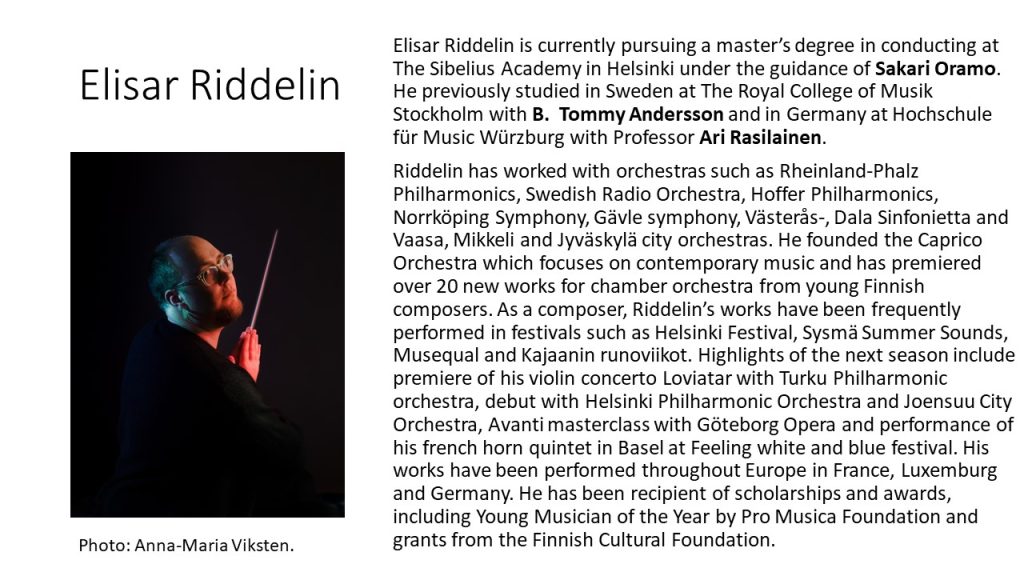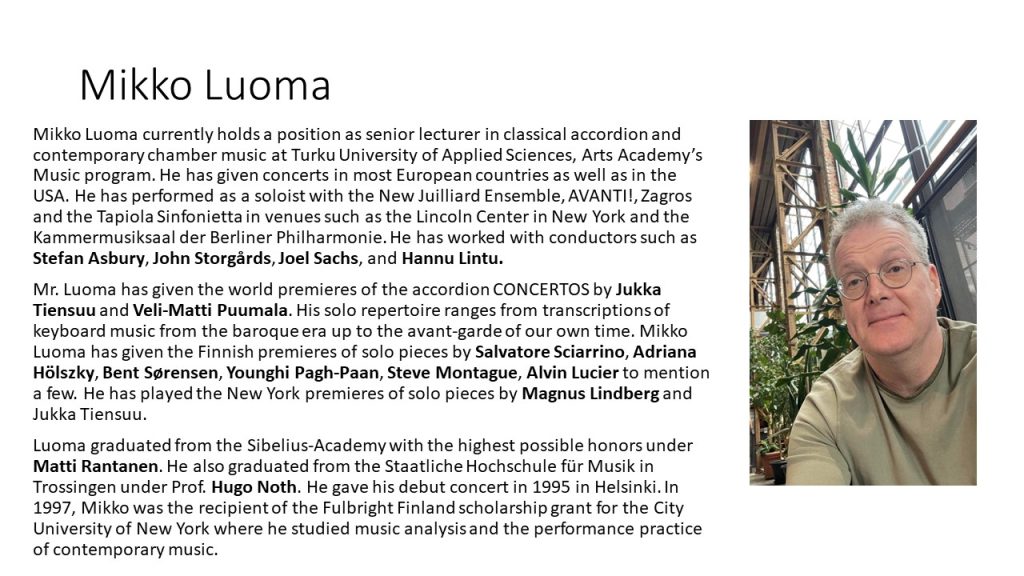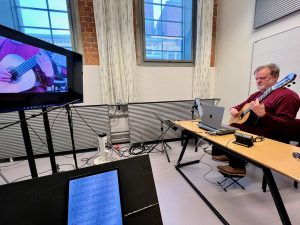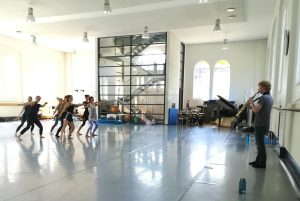This article is an overview of the current state of music education in Finland. The focus in this paper is…
Tekijät | Authors
Artistry, Pedagogy, and Humanity
David Yoken interviewed on April 12th, 2023, Conductor Composer Musician Elisar Riddelin and Turku UAS Arts Academy Senior Music Lecturer, Artist-Teacher, Mikko Luoma who is responsible for producing the Sigyn Sinfonietta: the “residence” student orchestra of the Turku UAS’ Arts Academy, Music program and the Turku Conservatory. The interview focused on Elisar’s guest conductor appearance with the Sigyn Sinfonietta during the week commencing February 6th, 2023, and his preparing this student orchestra for their Friday February 10th evening full length evening performance. It was an “international orchestra” in that the Poland’s Stanisław Moniuszko Academy of Music in Gdańsk sent several of their talented instrumental students to Turku to continue the tradition of collaboration between their institution and the Arts Academy’s Finnish and international music students.
On Friday February 10th 2023, the Sigyn Sinfonietta orchestra performed an evening of music composed by the American composer Charles Ives (1874-1954), the Finnish composer Erkki Salmenhaara (1942-2002) and the German composer Johannes Brahms 1833-1897). Both Charles Ives’ “Central Park in the Dark” composed in 1906 and Erkki Salmenhaara’s “Sinfonietta per Archi” composed in 1985 are rarely heard compositions. In this interview, Turku UAS Arts Academy’s Senior Music Lecturer, David Yoken, dialogued with Elisar Riddelin and Mikko Luoma about several topics including the musical repertoire selection process, Elisar’s pedagogical role and interaction with young musicians, and importantly Elisar’s compositional profile with the May 5th Turku Philharmonic Orchestra’s premier of his orchestral composition for solo violin and orchestra titled “Loviatar”. “Loviatar” has been commissioned by the Turku Philharmonic Orchestra’s and composed for their Concert Master, violinist, Matti Koponen.
The Repertoire
David: Would you please share with us the process of selecting the specific repertoire of the Ives, Salmenhaara, and Brahms for the February 10th concert. How did you arrive with these three composers?
Mikko: This was the second out of three concerts the Sigyn Sinfonietta performs during the academic year. For this second concert we planned to have a larger ensemble, this chamber orchestra, versus the smaller ensembles in the first and third concerts. Once the overall context of these three concerts was structured, Elisar and I began a dialogue regarding this second concert he would conduct, and he brilliantly understood what we “needed” as far as the repertoire. Elisar had several ideas regarding compositions, and it was at this point we discussed the opportunity to have Erkki Salmenhaara’s “Sinfonietta per Archi”. Elisar suggested having one of the Ives’ compositions, the “Central Park in the Dark” before and “The Unanswered Question” after the Salmenhaara.
Elisar: Although I had not conducted the Ives’ pieces, of course I knew about them. They were on my “To Do List”, and when Mikko and I started to think about the programming of the concert, it was almost like having this word association game, where I would say one composer and Mikko would answer with another, and back and forth between us. I also went through some music programs from the Sigyn Sinfonietta previous seasons. At first, we thought about paring the Polish composer Witold Lutosławski’s “Venetian Games” with Salmenhaara’s ”Concerto for two Violins”, but then as we further discussed the programing this changed to Salmenhaara’s “Sinfonietta per Archi” and the two Ives’ compositions. Salmenhaara was the composer we wanted to have for sure.
And then we were thinking about the pedagogical aspect of having the second half of the concert with a lot of orchestral excerpts, and the Brahms’ Second Symphony could offer a real sense of positive musical accomplishment for the music students. Compositions which are difficult for students to perform: somehow the whole experience can often become unfulfilling and frustrating.
The Salmenhaara composition is rather minimalistic. We needed to find music that would balance with the delicate sense of the Salmenhaara. Lutosławski’s “Venetian Games” would just devour the Salmenhaara. But the two Ives’ pieces could work. And the fact is that music students rarely play “Central Park in the Dark” and “The Unanswered Question”. They may have studied these pieces in their music theory or history classes, but then later in their careers they are in a professional setting, and they have a surprising or kind of uncomfortable experience performing compositions such as these which are rather “conceptual” in nature. So, this was also a very good pedagogical experience for them to perform these Ives’ compositions.
And then about the two Ives’ pieces, they are like sister works and I always have been curious as to why they are never performed together. And then I thought this could be a kind of brilliant “bridge” between the Ives’ “Central Park in the Dark” and Salmanhaara’s “Sinfonietta per Archi” which is then followed back to the Ives’ “The Unanswered Question”.
The Pedagogy
Mikko: I would like to also speak about the way Elisar directed the rehearsals. This was for me, the greatest form of pedagogy. When the rehearsal started, it went like a zeppelin, steadily rising all the time…getting better with each rehearsal…the students gaining more confidence in their own performance of the repertoire. Basically, I have never seen a student orchestra in such a natural state of concentration that was not forced, just concentrating on the essential listening, working on getting it right, again not forced. There was this growing, developing natural intensity in the ensemble playing. And I thought one can have seminars and one can reflect by writing essays on these pedagogical approaches, but if you do not really have such an experience as the students had during the actual rehearsal time with Elisar, in a way it is useless, the analysis and theorizing about such musical, creative experiences. To be aware of the connection between the pedagogy and the actual music making is one of the great takeaways from the week of having Elisar working with the music students.
David: Elisar would you be able to reflect on this issue about which Mikko has spoken?
Elisar: During the week I was with the music students, I was thinking of having a similar kind of attitude as working with professionals: that it is a waste of time if we are going to do things half asleep. It’s always good to have this psychological approach that we are going to be productive, but the atmosphere can still be positive and yet also have a relaxed feeling that you are able to make mistakes.
I think the biggest difference we have between student orchestras and many professional orchestras is that professional orchestra musicians play on such a high level. But often with student orchestras, there is an unevenness, because they are students. But this all is correlated with the energy, and the energy always seems to come through. I am now speaking on a very meta level, but I do believe this. Especially when we are speaking about a student orchestra, as a conductor, it is my job to control the energy that will come through, or how does one say it, to tame this energy a little or redirect it to the useful things.
Mikko: All about which Elisar is speaking, pretty much articulates what I observed. The students were able to have these very long stretches of continuous concentration. One result from the rehearsal setting, is that sometimes, in my experience regarding the students, the dress rehearsal can go quite well, but then because of lack of experience being in a concert situation, their nerves take over a bit and it turns out that the dress rehearsal was actually the best performance. However, with very good professionals the dress rehearsal can be somewhat mediocre, but then these professionals say “Ok this happened in the dress rehearsal. We better make it so that it doesn’t happen in the concert.” Again, what I observed with the students was the growth was truly happening throughout the week leading to the Friday night concert.
Elisar: I always remember what my first conducting teacher, said quite well. He said that for young conductors, the biggest cardinal sin is to come in front of the orchestra and hope for better players. Because it’s your job as a conductor to make them better. This has stayed in my mind because this is so true. The conductor’s job to make the music students better. And seeing this kind of steep curve and the results that happened with the Friday night Sigyn Sinfonietta’s concert, was so very rewarding for me.
The premiere of “Lovitar”
David: Elisar would you please speak about the Turku Philharmonic Orchestra’s premiere of your composition on Friday May 5th.
Elisar: The whole idea started when Matti Koponen the orchestra’s concertmaster called me and said “Hey so I’ve been listening to your music. Would you write a violin concerto for me?” And my reaction was “Well why not?”! I have been writing a lot of chamber music compositions, but I was thinking that I would like to compose something for a larger ensemble.
And Matti and I started to speak together. I told him that many of my compositions are somehow related to Finnish mythology, and Matti said he also was interested in this subject. But he had also been reading a lot about Egyptian mythology. So, I said “Let me see, as many of these Finnish and Egyptian stories have a similarity though a different cultural context. Let me try to find a story that might be able to combine two very different cultures.”
I found an Egyptian goddess of the night who was born in the underworld out of a primal force and chaos. And then I started to read from the Finnish mythology that there is a goddess of death, Loviatar, who was the daughter of Tuoni, and Tuoni was the river in the underworld. So, I thought, here I found the similarity.
And then there were certain elements that Matti wanted in a concerto where there is also something for the orchestra to play, which I fully understand, because often the concerto is the solo virtuosic part, and the rest of the orchestra is just playing some very quiet notes! I wanted to kind of make this composition in a very symphonic form.
And there are the mythological stories behind this composition, but I never compose music that is a story, but that maybe you can hear in the music “stories”. “Loviatar”, the violin concerto’s title is not a narrative.
There are four movements, and each movement has narrative like elements in my mind, but when I am in my composing process, I take an eraser and remove these elements and try to make it more cohesive in the “big picture” of the composition. In a way, I can say there are five movements, as there are four movements, and in between the third and the fourth movement there is a long solo violin cadenza. Because piano and violin concertos are the most played concertos, there are no straight musical quotations, but nods [he says with a laugh!], as I did not want to ignore the fact that there have been hundreds of thousands of concertos written. There are some interesting sections where, for example the solo violinist is playing with three drums and one of these drums is a Japanese Taiko drum. It is very interesting to find a balance between this barbaric soundscape and a smoother sense in the music…a balance between these two.
The composition is very difficult for the solo violinist. I wanted to make a virtuoso violin concerto. I know Matti as a player, and he is fantastic, one of the best concert masters in Finland. As he is such a brilliant player, I really wanted to make a piece that really brings his strengths out. The composition is very classically demanding.
As a composer, I am not so often using extended instrumental techniques. I write in very traditionally manner, but I want to extend to the classical range of the player.
Matti says the composition is extremely difficult, but he likes it very much. I’m so happy because the way in which he talks about it, I feel that he really understands, he really gets the music, which is of course for a composer is very important and gratifying.
Humanity
David: Elisar, having been an audience member myself on Friday February 10th I observed that we are sitting in this space, the Sigyn Concert Hall…there are the Finnish music students, the international music students at our Arts Academy, the Polish students from Gdansk, and outside in the world, there are so many horrible things happening…but here in this space and at this moment there is a connection an understanding, and this is what you do: you bring people together.
Elisar: I always say that my favorite quote is:
Always try to be nice, but never fail to be kind.
This is something that resonates with me as a person and as an artist because for me kindness is the driving force. This kindness is the humanity and the understanding of each other.
David: A wonderful way we can end today. I thank you both so much for the privilege of your time speaking with me.
This article is published simultaneously in English and in Finnish. You can find the Finnish translation here.
You can find more information:
Turku Philharmonic Orchestra, Loviatar 5.5.2023, Turku Concerts Hall









